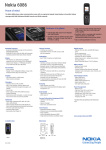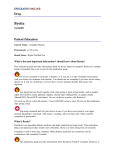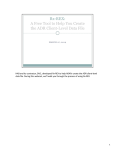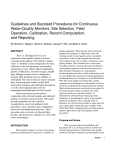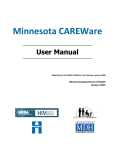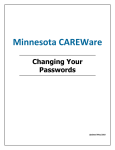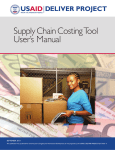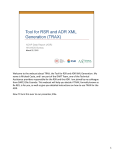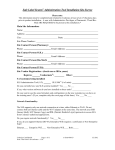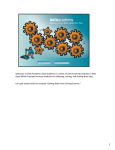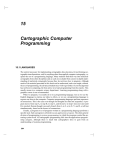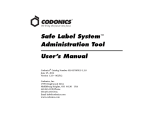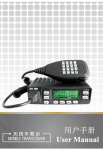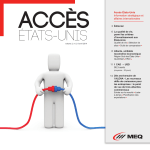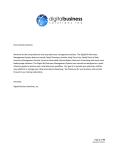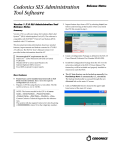Download today`s webcast. Thank you so much for joining us
Transcript
[Moderator] Welcome to today’s webcast. Thank you so much for joining us today! My name is Peggy O’Brien‐Strain of Mission Analytics Group. I am a member of the DART Team, one of several groups engaged by HAB to provide training and technical assistance to state ADAPs during the implementation of the ADR. T d ’ Today’s presentation addresses “Tools for Reporting Medications in the ADAP Data Report (ADR)”. t ti dd “T l f R ti M di ti i th ADAP D t R t (ADR)” Our presentation will be led today by Kelly Morrison Opdyke of CAI (Cicatelli Associates Inc.) – also a member of the DART team. We also have several members of HAB’s TA contractor teams available on the line today to help answer your questions. At any time during the presentation, you will be able to send us questions using the “Question” function on your control panel on the right hand side of the screen You will also be able to ask function on your control panel on the right hand side of the screen. You will also be able to ask questions directly “live” at the end of the presentation. You can do so by clicking the raise hand button (on your control panel) and my colleague, Titi, will conference you in; or, you can click the telephone button and you will see a dial in number and code. We hope you consider asking questions “live”, we really like hearing voices other than our own. Now I’ll turn the presentation over to Kelly. 1 [Presenter] Thank you, Peggy! Today’s webcast describes the tools available for ADAPs to report client medications. These include CAREWare, Rx‐REX, the NDC/D‐Code crosswalk, and custom requests for Multum database tables Multum database tables. Not sure which situation fits you? In this presentation, we’ll review the options to help you determine what you may need. But first, let’s review the reporting requirements. 2 The purpose of the Drugs and Drug Expenditures section is to describe the ADAP‐funded medications (i.e. ARV, Hepatitis B, and Hepatitis C medications) dispensed to clients during the reporting period and the total expenditures for those services. This section is only for clients who were dispensed ADAP‐funded medications that were paid for in full by ADAP. (See page 20 of the ADR Instruction Manual for more information). The ADR Instruction Manual is available from the HAB website: http://hab.hrsa.gov/manageyourgrant/files/hab2012adrmanual.pdf 3 As a reminder, you would not report medications that were purchased by the ADAP and then billed to insurance, those for which only co‐pays and deductibles were paid (those would be reported under insurance), or medications other than ARVs, Hepatitis B and Hepatitis C medications. So for example, if your formulary covers mental health medications, those are not included. 4 There are five data elements in the ADR Client Medication Table, corresponding with Items 25‐29 of the ADR Client Report. If the response to Item 25: Receipt of Medication Services is “Yes” for a given client, then you must report four additional data elements. You’ll report each ADAP‐funded medication dispensed to the client during the reporting period. For Item 26, you For Item 26 you’llll report the Medication ID. Use the five report the Medication ID Use the five‐digit digit drug code (or drug code (or “D‐Code”) D Code ) (d#####) for the medication. You’ll also report the Medication Start Date (Item 27), Days Dispensed (Item 28), and Cost for Medication (Item 29). So, why did HAB choose to require D‐Codes for the ADR instead of some other drug identifier, such as NDC or drug name? The main reason is that there many, many drugs with different names and product codes that vary across state data systems. HAB needed a way to standardize and simplify drug reporting for the ADR. D Codes are unique 5 D‐Codes are unique 5‐digit digit codes assigned by Multum. You may also see d codes assigned by Multum You may also see d‐codes codes referenced as “DNUM” or drug number, or “DIN” which stands for drug identification number. The d‐code is the same for all drugs with the same Generic Name. So, instead of needing to track and report hundreds of individual drug product codes for the ADR, there are just a few dozen d‐codes you’ll need to report. 6 So, now that you know what you need to report, let’s review what tools are available for you to use. If you use CAREWare, you’re ready to go because the information that you need is built into CAREWare. Now, you’ll need to set up your ADAP formulary in the data system, but other than entering the medication that was dispensed to the client, start date, days dispensed, and cost, you’re all set. You just need to make sure that you receive this information from your pharmacy PBM or other provider your pharmacy, PBM or other provider. Now, if you don’t plan to use CAREWare, but you already get all of this information from your pharmacy, PBM or other provider, you can use Rx‐REX. Rx‐REX let’s you pull the information that you have into an application that puts it in the right format. However, it doesn’t “add” any missing information, so you need to make sure that you have what you need already – including d‐codes. I’m going to quickly review both CAREWare and Rx‐REX and where you can find these resources. 7 If you are using CAREWare: The CAREWare ADAP drug services module is designed to allow grantees who manage these services to track in detail client level AIDS Drug Assistance information. The module includes a complete medication list, and all client‐level fields required for the ADR. CAREWare uses the Multum medications database as the source of data for the medications list The medications list is extensive and contains virtually all approved drugs medications list. The medications list is extensive, and contains virtually all approved drugs, cross‐referenced by generic ingredient, along with the associated d‐codes, brand name, and NDC. 8 In order to enter ADAP drug services for your clients in CAREWare, you’ll need to setup your active formulary. This includes finding the medications, adding them to your active list, and supplying any available default information such as drug dispensing fee, unit cost of the medication, and days typically prescribed. These settings can always be edited and even changed at the point of client‐level data entry! For step‐by‐step instructions on setting up your drug formulary in CAREWare, please refer to the manual on “How to the manual on How to use the CAREWare ADAP Module to complete the ADAP Data to use the CAREWare ADAP Module to complete the ADAP Data Report (ADR)”. You might also find it helpful to review the November 2012 webcast archive on “Using CAREWare for the ADAP data report”, which is available from the TARGET Center (https://careacttarget.org/library/using‐careware‐adap‐data‐report). Note that HAB just this week released a new CAREWare build with all the ADAP ADR report functionality available. As a result of some extremely helpful testing, we were able to address some important slowness issues related to processing large amounts of data imported through the PDI and HL7 parser. Grantees in Chicago and Florida in particular have helped us in this area. Thank you! 9 If you plan to use Rx‐REX to create your XML file: You’ll first need to download the Rx‐REX package, including the User Manual and sample ADR Client Tables, from the TARGET Center website. https://careacttarget.org/library/rx‐rex‐package You’ll also need to install the Rx‐REX application from the link provided on the TARGET center website center website. For more help using Rx‐REX, please refer to the User Manual. You may also find it helpful to review the webcast archive for the March 27, 2013 Rx‐REX webcast on the TARGET Center. 10 After you download the Rx‐REX zip package from TARGET, you’ll want to review the ADRClients_Sample_Tables Excel spreadsheet, which contains a tab for every table in the Rx‐REX Access database. You will report drugs and drug expenditures in the ClientReportMedication table. You will report each time the medication was dispensed to a client. So, you may have multiple rows corresponding to one client. Remember, you’ll need to get d‐codes before you put your data into Rx‐REX. In the example you see here, the table has been populated for a client that received the same drug (Atripla) on the first of each month. We report each time the drug was dispensed during the reporting period, including the appropriate d‐code. The “ClientReportID” helps link this client’s data to the ClientReport table that contains client demographic data. 11 So now we’re going to discuss what to do if you aren’t going to use CAREWare, and don’t already have the d‐codes that you need to report. For example, perhaps you collect NDCs, or brand names, and need to add d‐codes to your database. How can you do that? Don’t worry! HAB has two resources available to help you. The first resource that I’d like to discuss is Multum. However, first you need to determine if this is what you need Multum information is provided in lookup tables So it is a good this is what you need. Multum information is provided in lookup tables. So, it is a good option if you use Access or Sequel and are used to using lookup tables, or have a programmer who knows how to work with lookup tables. Now, if this isn’t the case, we also have the NDC to D‐Code Crosswalk. The crosswalk contains an Excel table that lists all ARVs, Hep B and C medications, and their corresponding d‐codes, brand names, and generic names. If you use the crosswalk, you would have to have a way to take the information that you do collect regarding medications and write a program to “translate” it to the information that you need. This may mean using Excel, SAS, or another program to help translate the information. Now that I’ve reviewed these, let me tell you how you can get this information. 12 If Multum fits your needs, you will need to complete a form to request medication information from the Multum Drug Database. This database will enable you to collect, manage and submit required data to HAB. HAB contracts with Lexicomp, the proprietors of the Multum database to allow HAB to provide medication information to their funded grantees. In order to be eligible to receive this information, you must use it for the purposes of HAB reporting outlined in your request and you may not share it request, and you may not share it. You can download the request form from the TARGET Center, or email [email protected] to request a copy. [See also]: https://careacttarget.org/library/adr‐update‐d‐codes‐added‐ndc‐crosswalk‐available 13 To ensure that your request is in alignment with HAB’s contract, you’ll need to provide some basic information. First, you’ll need to tell us for which HAB reporting requirement are you requesting the Multum medication information? ‐ For example, you might say the ADAP Data Report. Next you’llll need to describe how you will use the Multum medication information. Next, you need to describe how you will use the Multum medication information ‐ For example, you might indicate that will it be used as lookup files for a data application. Finally, you’ll need to indicate which data items you are requesting from the Multum database. ‐ This might include, NDC, Brand Name, D‐code, or Generic Name. Please only request the variables you need. Note that the Multum database is updated each time a new drug is released, although there is some time lag. So, you’ll need to make sure that you routinely update your d‐ codes as your drug formulary evolves to ensure that you have all of the codes you need when you need them. In other words, this is not a one time process. 14 Grantees should submit the completed form via email to [email protected] with the subject line “Multum Database Request”. bj li “ l b ” Requests will be processed and logged by the DART team. Once we receive the completed form, we’ll review it to ensure that it is complete and forward it to HAB. If it is not complete, we’ll return it to you with instructions to complete the missing information. If it is complete, we’ll let you know that we have forwarded the information to HAB for review. review HAB will review the request to determine if it aligns with their user agreement with Lexicomp. HAB will then inform DART and SAIC of the outcome of the review (i.e. approved, not approved). If not approved, HAB will provide a reason why. DART will inform you of the decision and, if approved, you will receive the file directly from SAIC in the near future. HAB sends the request to SAIC. SAIC will send you an encrypted file with the Multum medication information. HAB will send a final email to you that outlines the terms of use of the medication information, and the password to unlock the file. 15 Now I’m going to talk about the NDC to D‐Code Crosswalk. This is another option to find the MedicationID, or “d‐code”, that you need to report. In order to ease use of d‐codes for grantees that use the National Drug Code (NDC) to collect medication information, HAB has made available a NDC to D‐Code crosswalk as part of the ADR download package. (The link is provided on this slide). The Crosswalk is an Excel spreadsheet that lists the DIN, drug identification number (or “d‐ code”) that you would report for the ADR, alongside the Generic Name, Brand Name, 9‐ digit CMS NDC labeler, and 8‐digit FDA NDC labeler. As previously noted, the d‐code is the same for all drugs with the same Generic Name. Now for both the Multum database and NDC to D‐Code Crosswalk, when a new medication or a new brand name, or dosage comes out, these resources need to be updated. HAB will ensure routine updates of both resources to address these needs. 16 On this slide are web links where you can find the tools and resources described in today’s presentation. Today’s webcast will be archived on the TARGET Center. There you’ll be able to review these slides, along with a recording of the webcast presentation. You’ll also find the link to download the Multum database request form. Or you can simply type “Multum” in the TARGET Center search box and you’ll see the link on the search results page. 17 Also, don’t forget to join us for our upcoming webcasts. You can register online at the TARGET Center. At this time I’ll turn it back over to our Moderator for questions. Peggy? 18 [Moderator] Thank you! We will now take questions. As a reminder, you can send us questions using the “Question” function on your control panel on the right hand side of the screen. You can also ask questions directly “live.” You can do this by clicking the raise hand button (on your control panel). If you are using a headset with a microphone, my colleague, Titi, will conference you in; or, you can click the telephone button and you will see a dial in number and code. We hope you consider asking questions “live”, we really like hearing voices other than our own than our own. We do want to get all of your questions answered, and we do not usually run over an hour. If you have submitted your question in the chat box and we cannot respond to your question today, we will contact you to follow up. We often need to explore your question in order to give you the most appropriate answer. [Moderator reads questions from the log while Organizers “assign” [Moderator reads questions from the log while Organizers assign these to appropriate these to appropriate panelists and presenters]. 19 As always, feel free to contact any of the TA contractors for all of your questions about data and reporting. reporting. You can also contact your Project Officer to help you make TA requests or answer programmatic questions. If you’re not sure who to call, don’t sweat it, call any of us. As you exit this webcast today, we’d like your feedback on this webcast presentation. On your screen you will see three evaluation questions appear. Please take a moment to respond to each. We appreciate your feedback very much, and use this information to plan future webcasts. Thank you for joining us! 20





















